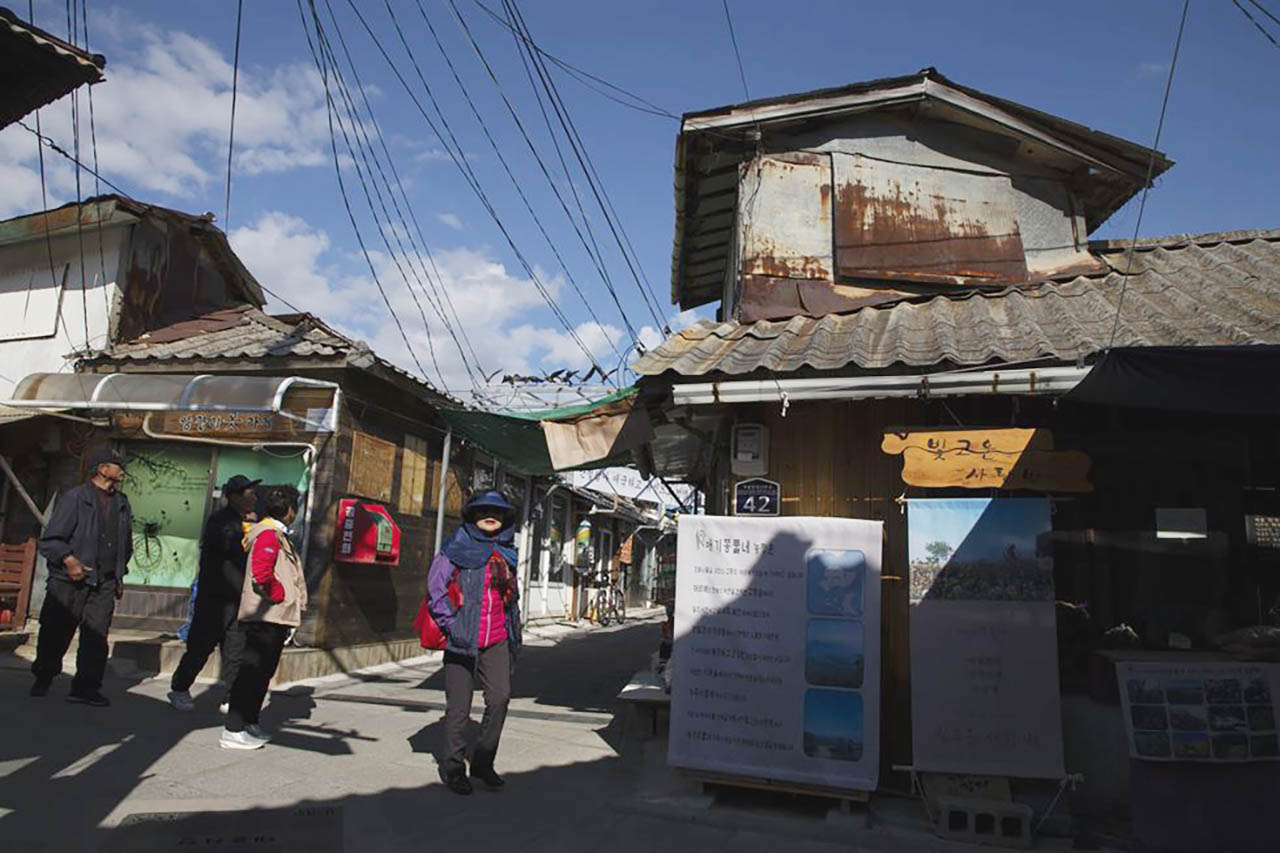
Daeryong Market, the one and only major market located in the center of Gyodong Island, is a place where time has stopped. Like a broken old chiming wall clock, time has stopped at somewhere between the 1960s and 1970s.
Walking through the marketplace, those small old slate-roofed shops selling popular snacks and various necessities of the time, vintage tea houses, a rundown drugstore, a barber shop and a clock repair shop bearing all the traces of time, give visitors the surreal feeling of being channeled into the past.
“It’s been quite a long time since I’ve seen as many people as these days. I have mixed feelings about the tourists coming here, both good and bad,” a pharmacist’s old wife said in a small voice and a graceful smile over the counter at Gyodong Island’s only drugstore Dongsan Drugstore, which has been running since 1971. The store is stacked with bug repellents, bottles of sanitizers and vitamin drinks. “Old residents still work in the fields and they often come here for arthritis drugs or pain relieving patches.”
The market thrived with some 30,000 residents bustling during and after the 1950-53 Korean War, including 20,000 North Korean refugees who fled their homes in Yeonbaek, Hwanghae Province.
As a walkable small stretch of river during low tide was designated as inside the Civilian Control Zone, those separated families settled in Gyodong, wishing for the day they can hear from their families and return to their homes. Those 20,000 displaced North Koreans created a market that looks like Yeonbaek Market in their hometown in the North and it became Daeryong Market with a unique culture.
As many North Korean refugees have died from old age and their young children left the island looking for better jobs, Gyodong’s population shrank to 3,000. Schools closed and the market nearly lost its life.
The breakthrough came when Gyodong Bridge was built connecting the island with the mainland.
Lee So-yeon, a 27-year-old woman from Incheon, dressed in a 1970s school uniform with her three high school friends, said she chose the marketplace as the first destination for their annual friendship trip.
“I really thought it would be as much fun as meaningful, wearing school uniforms together. I like the warm feeling this vintage marketplace gives,” she said while waiting to buy one of its famous street foods, twisted doughnuts.
Her friend Park Jee-su added “In Gyodong we can look over the river; the North Korean villages and its people are so close. It is really striking for me that from here, the distance to the North is nearer than to my home in Incheon.”
In one corner of the market, old women stack on the ground vegetables they have grown from their fields. In another, a camera is busy rolling to shoot a drama with many extras, with the backdrop of hanging banners written with 1970s slogans like “Catch North Korean Spies” under the former dictator Park Chung-hee government and posters plastered on the walls promoting various government campaigns during the time like “catch mice that steal the wealth of people” or “Let’s have just two kids and educate them better.”
“This place was not like this before. Empty stores after its owners left for the mainland were left to ruins and the area became a dilapidated place that no one would like to visit,” said Sohn Hyo-suk, a 64-year-old woman working at a photo studio that rents old school uniforms to tourists and takes pictures of them. “After Gyodong Bridge was established in 2014 and by restoring and cleaning up the marketplace, we are getting to see a great rise in tourists.”
The studio’s walls are covered with many black-and-white photos of middle-aged or older women and men in school uniforms.
As the place earned its fame as a favorite spot for photos among young people and many TV shows have been shot in the place, the number of her customers during the weekends grew more than 10 times to 200 to 300 now, from only 20 to 30 a year ago. After the new bridge, around 300 people have moved to the island, according to Sohn.
Touring around the market, one notable thing is the presence of real birds’ nests and little swallow figures almost everywhere in the market. The information center of the island is actually called the “Swallow’s Nest.”
Separated families in Gyodong, by looking at the swallows that carry mud pellets they collect in their beaks from the soil of the North, were said to have soothed their longing for returning home.
Source: The Korea Times